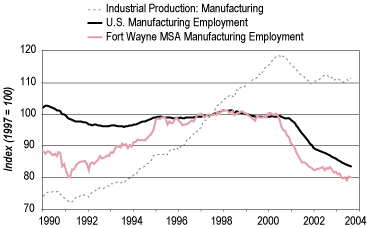Fort Wayne
Associate Professor of Economics, Indiana University-Purdue University, Fort Wayne
Manufacturing is disappearing. No, it’s manufacturing employment that’s disappearing. As shown in Figure 1, the total value of goods manufactured in the U.S. has declined approximately 6 percent since mid-2000, but that’s not exactly a disappearing act. Furthermore, when the 6 percent decline is juxtaposed with the almost 60 percent increase in the last decade, it appears modest indeed. Isn’t that a typical characteristic of recessions?
Figure 1
Manufacturing Output and Employment

Look for the value of goods manufactured to reach new highs in the next twenty-four months as the current recovery gains momentum. That’s not exactly a disappearing act.
What’s disappearing is manufacturing employment. In 1978, there were over 19.3 million employed in manufacturing in the nation. Last November, there were 14.5 million. That’s a total decrease of 25 percent, or essentially 1 percentage point per year.
Between 1978 and last November, the total value of goods manufactured in the U.S. increased 90 percent. It had doubled as of mid-2000. Why the disconnect? Productivity—the increase in output per hour of labor.
Between 1978 and 1995 nonfarm business productivity grew at an average annual rate of about 1.2 percent. From 1996 to the fourth quarter of 2001—the end of the last recession—productivity averaged around 2 percent. Since the recession ended, productivity has expanded at an annual rate of more than 5 percent. In third quarter 2003, productivity grew at a seasonally adjusted annual rate of 9.4 percent. In classic understatement, Federal Reserve Chairman Alan Greenspan has described the surge in productivity as “startlingly large.”
Frankly, the third quarter 2003 productivity number is too high to be believed,
so it more than makes a point. And the point is that advances in productivity
have more than accounted for the economy’s post-recessionary growth.
It’s why a million jobs have disappeared since the start of the recovery
in November 2001.
In the last three years, manufacturing employment in the Fort Wayne metropolitan
area (1) has decreased by approximately fifteen
thousand; or more starkly, basically one in every five manufacturing jobs has
disappeared over the last thirty-six months (see Figure 1).
Due to the massive fiscal and monetary stimuli, the U.S. economy is now growing sufficiently fast to begin generating jobs (see “The U.S. Economy”). When economic growth exceeds productivity growth—which is about to occur—the modest employment gains will accelerate.
For the Fort Wayne area, the immediate question is when will the fifteen thousand laid-off manufacturing workers be called back? According to a recent research note from the Federal Reserve Bank of New York, the answer for many will likely be never:
“The period after the 2001 recession will be remembered as the second jobless recovery. (2) Our inquiry into the reasons for the current labor market slump suggests that structural change has played an important role. Industries that lost jobs during the recession have continued to shrink during the recovery, and permanent job losses have eclipsed temporary layoffs. … An unusually high share of unemployed workers must now find positions in different firms or industries.” (3)
Unfortunately, the researchers didn’t quantify “unusually high,” so I am forced to.
Let’s assume 5,000 of the 15,000 area manufacturing jobs lost return over the next two years; that’s 2,500 jobs a year.
During normal times, the Fort Wayne area economy has been generating approximately 2,500 nonmanufacturing jobs yearly.
For 2004, these assumptions yield a forecasted increase of 5,000 jobs, or approximately a 2 percent increase in employment ending in December. This is the most optimistic end of the forecast range. One percent, or 2,500 jobs, is the pessimistic end.
Over the longer run, the capacity of the Fort Wayne area to grow employment is likely about half that of the nation. This is based on the area’s relative dominance in the slow growth manufacturing sector (4) and its relatively low population growth.
Endnotes
- Adams, Allen, DeKalb, Huntington, Wells, and Whitley counties.
- Actually, they are wrong. Recovery from the 1990–91 recession was job-less. Recovery from the 2001 recession has been job-loss.
- Erica L. Groshen and Simon Potter, “Has Structural Change Contributed to a Jobless Recovery?,” Current Issues in Economics and Finance 9 (August 2003).
- Actually, the argument above is that the secular trend is for decreased manufacturing employment.
Also in this Issue…
- Outlook for 2004
- The U.S. Economy
- The International Economy
- Financial Forecast
- Corporate Governance and Reporting
- Housing
- Indiana
- Anderson
- Bloomington
- Columbus
- Evansville
- Fort Wayne
- Gary
- Indianapolis
- Kokomo
- Lafayette
- Muncie
- New Albany
- Richmond
- South Bend/Mishawaka and Elkhart/Goshen
- Terre Haute
- Outlook Summary for 2004



